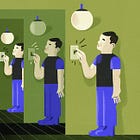Once a week, we write this email to share student-written work on science. Consider spreading the word to support us and win referral awards.
The Rise of CRISPR: Revolutionizing Genetic Engineering
CRISPR stands for "Clustered Regularly Interspaced Short Palindromic Repeats." This name refers to the unique DNA sequences found in the genomes of bacteria and archaea. These sequences are part of the organisms' immune systems, allowing them to recognize and defend against viral invaders.
Cas9, an associated protein, acts as molecular scissors that can cut DNA at specific locations. By guiding the Cas9 protein to a precise spot in the genome using a custom RNA sequence, scientists can target and edit specific genes. This process can introduce new genetic material, repair damaged genes, or deactivate harmful ones.
Applications in Medicine
Genetic disorders, which are caused by mutations in DNA, can now potentially be corrected at the source. For instance, researchers are exploring the use of CRISPR to treat diseases like cystic fibrosis, muscular dystrophy, and sickle cell anemia.
In a landmark study in 2020, scientists successfully used CRISPR to treat a patient with sickle cell disease. By editing the patient's bone marrow cells to produce normal hemoglobin, they effectively alleviated the symptoms of this debilitating condition. This success story has fueled optimism about the future of gene therapy and its potential to cure genetic diseases.
Agricultural Advancements
Beyond medicine, CRISPR is set to revolutionize agriculture. Traditional methods of crop breeding are time-consuming and often imprecise. CRISPR, however, allows for targeted modifications that can enhance desirable traits, such as drought resistance, pest resistance, and nutritional content.
For example, scientists have used CRISPR to create wheat varieties that are resistant to powdery mildew, a common fungal disease. By editing genes associated with susceptibility to the fungus, they produced crops that require fewer chemical treatments, leading to more sustainable farming practices.
Similarly, CRISPR has been employed to develop crops with improved nutritional profiles. Researchers have successfully edited rice to produce higher levels of beta-carotene, a precursor of vitamin A. This biofortified rice, often referred to as "Golden Rice," has the potential to combat vitamin A deficiency in developing countries, where this deficiency is a leading cause of blindness and mortality.
A Word From Our Sponsor: SciSpace
SciSpace is a next-gen AI platform for researchers where you can easily discover 280 million+ papers, conduct effortless literature reviews, chat with, understand, and summarize PDFs with its AI copilot, and so much more.
Try SciSpace. If you love it, get 40% off an annual subscription with code STEM40 or 20% off a monthly subscription with code STEM20.
Quantum Chromodynamics: The Theory of Strong Interactions
Quantum Chromodynamics (QCD) is the theory that describes the strong interaction, one of the four fundamental forces in nature. It is a part of the Standard Model of particle physics and explains how quarks and gluons interact to form protons, neutrons, and other hadrons.
Historical Development
The journey of QCD began in the early 1970s when physicists sought to understand the strong force that binds quarks together. The theory was formulated by Harald Fritzsch, Murray Gell-Mann, and Heinrich Leutwyler in 1973. They proposed that quarks interact through the exchange of gluons, which are massless vector bosons.
Fundamental Concepts
Quarks and Gluons: Quarks are elementary particles that come in six flavors: up, down, charm, strange, top, and bottom. Gluons are the force carriers that mediate the strong interaction between quarks.
Color Charge: Unlike electric charge, quarks possess a property called color charge. There are three types of color charges: red, green, and blue. Gluons carry a combination of color and anti-color.
Confinement: Quarks are never found in isolation; they are always confined within hadrons. This phenomenon is known as confinement and is a direct consequence of the strong force.
Asymptotic Freedom: At high energies, quarks behave as if they are free particles. This property, known as asymptotic freedom, was discovered by David Gross, Frank Wilczek, and David Politzer, earning them the Nobel Prize in Physics in 2004….
Obsessive Compulsive Disorder: Understanding a Misunderstood Condition
Obsessive Compulsive Disorder (OCD) is a complex mental health condition that affects millions of people worldwide. Despite its prevalence, OCD remains widely misunderstood and often misrepresented in popular culture. This article aims to shed light on the realities of OCD, its impact on those affected, and current treatment approaches.
OCD is characterized by persistent, intrusive thoughts (obsessions) and repetitive behaviors or mental acts (compulsions) that a person feels compelled to perform in response to these thoughts. Contrary to popular belief, OCD is not simply a preference for order or cleanliness. For those with OCD, these thoughts and behaviors can be severely distressing and time-consuming, often interfering significantly with daily life.
The obsessions in OCD can take many forms, including fears of contamination, concerns about harming oneself or others, need for symmetry or exactness, or intrusive sexual or religious thoughts. Compulsions, which are performed to alleviate the anxiety caused by obsessions, might include excessive hand washing, checking, counting, or mental rituals like silently repeating phrases. These compulsions provide only temporary relief, perpetuating a cycle that can be difficult to break without treatment.
Research suggests that OCD arises from a combination of genetic, neurobiological, and environmental factors. Brain imaging studies have shown differences in the frontal cortex and subcortical structures of the brain in individuals with OCD….
Last Week’s Most Popular Post
Thought-Provoking Case Studies in Space Law
A compilation of the most exigent considerations for the future of space.
Despite the apparent abundance of the Low-Earth orbit (LEO) environment, fast-moving satellites, mega-constellations with thousands of satellites, tracked space debris, and untracked space debris are rapidly crowding the space. Developing nations without the current capabilities to launch satellites into LEO may soon lose the opportunity to do so. This imposes a border between nations in outer space, which is "not subject to national appropriation."
The STEMScribe blog is a reader-supported publication. Subscribe to show your support. It’s free!
If you would like to submit a guest post to the blog, please fill out this form. If you enjoyed this post, consider spreading the word.
Issue #10








